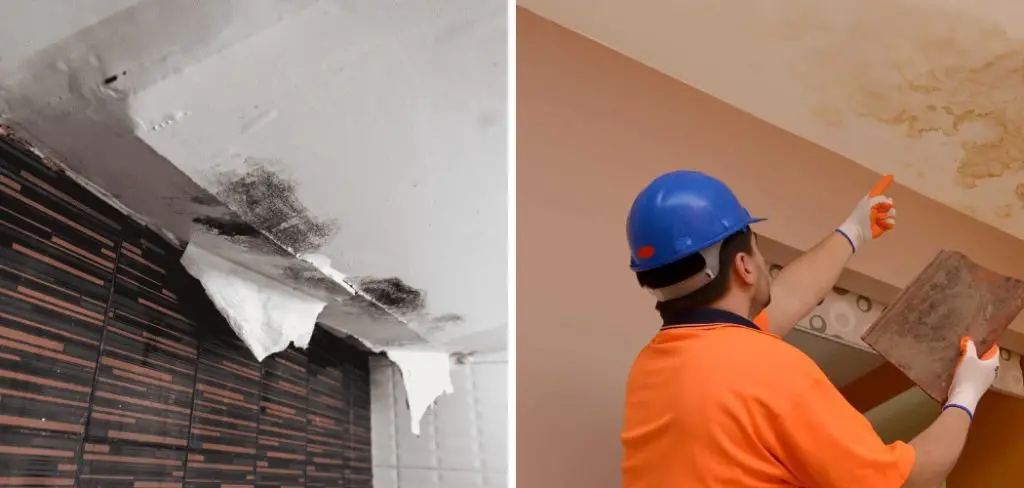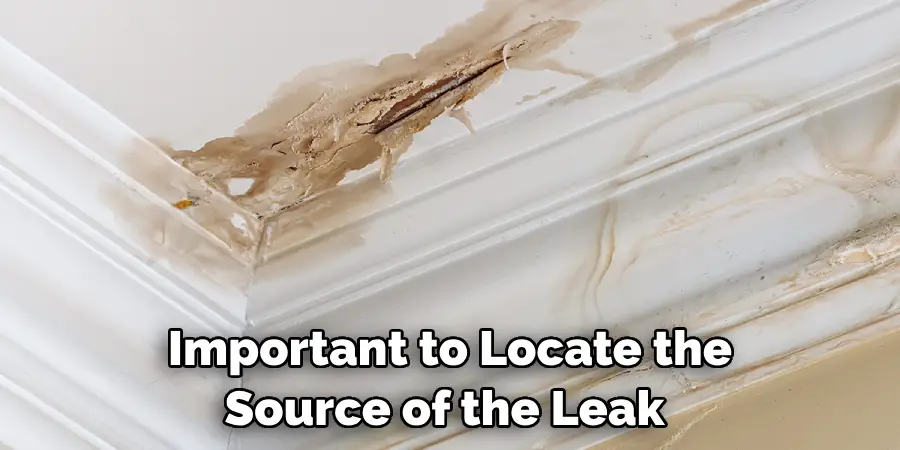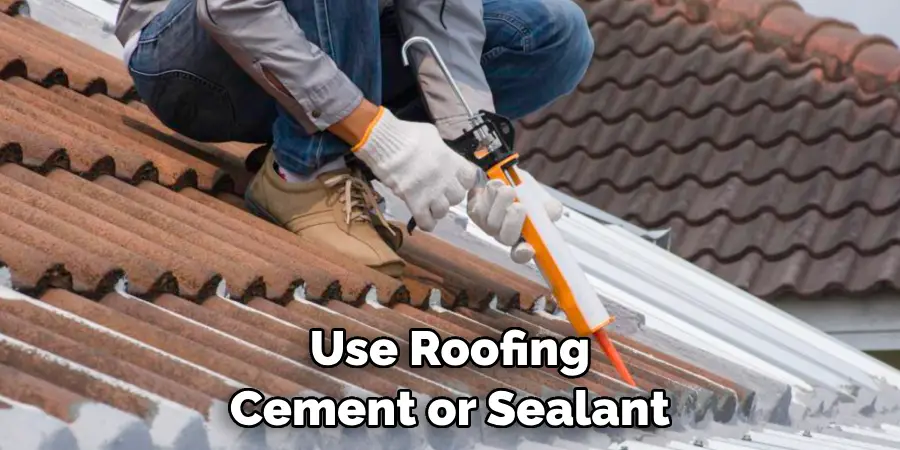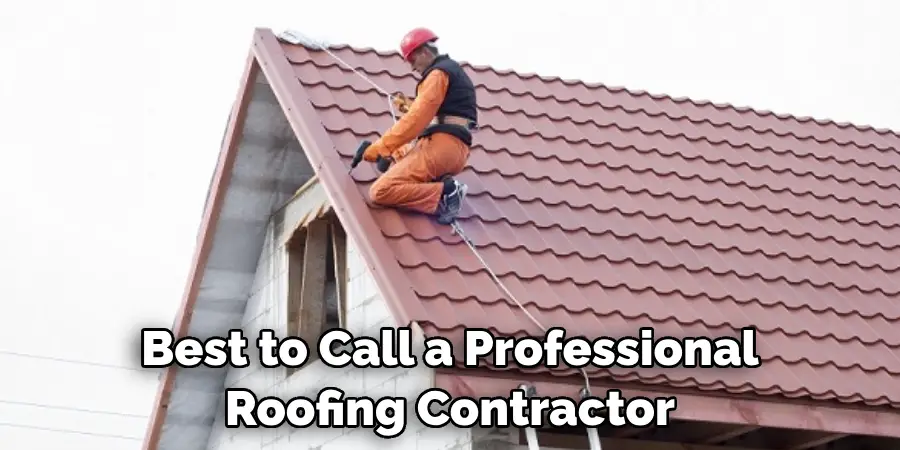A leaking roof can be a homeowner’s nightmare, causing water damage and potential structural issues. When addressing a leak from the inside, quick and effective action is crucial to minimize damage. Learning how to fix a leaking roof from the interior can be a temporary solution to mitigate immediate concerns until professional repairs are possible.

In this comprehensive guide, we will explore step-by-step methods for how to fix leaking roof from inside. From locating the source of the leak to implementing temporary fixes such as sealants and patches, we’ll provide practical tips to stem the flow of water and protect your home.
Whether you’re facing an unexpected leak or proactively preparing for a repair, this guide aims to empower homeowners with the knowledge needed to address and manage roof leaks from within, safeguarding your home from further water damage.
Recognizing the Signs of a Leaking Roof from inside
Water Spots and Stains on Ceilings
One of the most common signs of a leaking roof is water spots or stains on your ceilings. These can present as discolored patches or even dark rings, depending on how long the leak has been occurring. It is important to note that water stains are not always directly below the source of the leak, as water can travel along beams or pipes before dripping onto your ceiling.
Musty Odors
If you notice a musty smell in your home, it could be a sign of a leaking roof. When water seeps into the structure of your home, it can create a damp and musty environment that can lead to the growth of mold and mildew. These organisms thrive in dark and moist conditions, so a leaking roof can provide the perfect breeding ground for them.
Dripping Sounds
If you hear dripping sounds coming from your ceiling or walls, it is likely that you have a roof leak. This could be caused by water seeping through your roof and into your home, creating pools or puddles that eventually drip onto your ceilings or walls. If you hear dripping sounds, it is important to locate the source of the leak and address it as soon as possible.

Buckling or Warping
Another sign of a leaking roof from inside your home is buckling or warping on your walls or ceilings. This can occur when water is absorbed by drywall or plaster, causing it to swell and warp. If you notice any changes in the texture or appearance of your walls or ceilings, it could be a sign of a roof leak.
10 Methods How to Fix Leaking Roof from inside
1. Identify the Source of the Leak
The first step in fixing a leaking roof from inside is to identify where the leak is coming from. This may require climbing into your attic or crawling on your roof to locate the source of the leak. Look for any visible signs of water damage, such as stains or wet spots, and follow them to their origin.
2. Clear Out Debris and Clean Gutters
Clogged gutters can cause water to back up onto your roof and potentially lead to leaks. Make sure to clear out any debris, such as leaves or twigs, from your gutters regularly to prevent this issue. You can use a ladder to access your gutters and a gutter scoop or trowel to remove any debris. To avoid potential accidents, make sure to have someone hold the ladder steady while you work.
3. Patch Small Holes and Cracks
If you notice any small holes or cracks in your roof, you can patch them with roofing cement or sealant. Make sure to clean the area thoroughly before applying the patch and allow it to dry completely before testing for leaks. For larger holes, consider using a patch kit specifically designed for roof repair.
4. Replace Damaged Shingles
If you have asphalt shingles on your roof, they may become damaged over time due to weather or wear and tear. If you notice any missing or damaged shingles, replace them with new ones to prevent water from seeping through.
5. Check for Gaps around Chimneys and Vents
Chimneys and vents are common areas for leaks to occur due to gaps between them and the roof. Use roofing cement or sealant to fill in any gaps and create a watertight seal. You can also install flashing around chimneys and vents as an extra layer of protection against leaks. Additionally, make sure that the seals around the base of these structures are intact and not cracked or deteriorating.

6. Inspect Flashing
Flashing is used around chimneys, vents, skylights, and other protrusions on your roof to prevent water from entering these vulnerable areas. Check for any loose or damaged flashing and repair or replace it as needed. Sometimes, flashing can also be the cause of a roof leak. If you see any gaps or cracks in the flashing, seal them with roofing caulk.
7. Add Insulation
In some cases, a leaking roof can be caused by inadequate insulation in your attic space. Adding more insulation can help regulate temperature changes that can lead to condensation forming on the underside of your roof. This condensation can then drip down and cause damage to the interior of your home.
8. Install a Vapor Barrier
Similar to insulation, a vapor barrier can help prevent moisture from building up in your attic and causing damage to your roof. This is especially important in areas with high humidity levels. A vapor barrier is usually made of plastic or foil sheeting and should be installed on the warm side of your attic, between the insulation and the living space.
9. Use a Roof Coating
A roof coating can be applied to the surface of your roof to create a protective layer that helps prevent leaks. It can also extend the lifespan of your roof by protecting it from UV rays and other environmental factors.
There are various types of roof coatings available, including silicone, acrylic, and polyurethane. Each type has its own unique properties and benefits, so be sure to do your research before choosing the right one for your roof.
10. Call a Professional
If you are unsure about how to fix a leaking roof from inside or if the damage is extensive, it may be best to call a professional roofing contractor for assistance. They have the knowledge and expertise to properly diagnose and repair any issues with your roof.

Not only will a professional be able to fix the leak, but they can also identify any potential problems that may arise in the future. They can also provide advice on how to properly maintain your roof to prevent future leaks.
Things to Consider When Fixing a Leaking Roof
When it comes to fixing a leaking roof, there are several factors that need to be considered. A leaking roof can cause significant damage and pose safety hazards if not addressed promptly. Therefore, it is crucial to take the necessary precautions and approach the repair process carefully.
In this section, we will discuss some essential things to keep in mind when fixing a leaking roof.
Identifying the Source of the Leak
The first step in fixing a leaking roof is to identify the source of the leak. This may seem obvious, but it can often be challenging to pinpoint exactly where the leak is coming from. Water can travel along beams and rafters before dripping onto your ceiling, making it appear as if the leak is coming from a different area than it actually is.
One way to identify the source of the leak is by checking your attic or crawl space during a rainstorm. Look for any signs of water dripping or moisture on the walls or ceiling. You can also use a flashlight to look for any visible cracks, holes, or gaps in your roof that may be causing the leak.

Assessing the Damage
Once you have identified the source of the leak, it is essential to assess the extent of the damage. Is it just a small leak that can be easily fixed, or does it require major repairs? If there are significant structural damages, it may be best to call a professional roofing contractor.
It is also important to check for any mold or mildew growth caused by the leak. If left untreated, mold can spread quickly and pose health risks to you and your family.
Conclusion
In conclusion, a leaking roof can cause immense damage and frustration for homeowners. However, with the right knowledge and steps, it is possible to fix the issue from inside your home. By following all of the guidelines and tips mentioned in this blog post, you now have the power to save yourself time, money, and stress by taking care of a leaking roof on your own.
Remember to always prioritize safety and consult with professionals if needed. With determination and proper execution, you can successfully repair your leaking roof and protect your home from further damage. So, there you have it – a quick and easy guide on how to fix leaking roof from inside.
